
“Just a short time ago it would have seemed like a Quixotic adventure in the colonised, neocolonised, or even the imperialist nations themselves to make any attempt to create films of decolonisation that turned their back on or actively opposed the System.“
Fernando Solanas and Octavio Getino – ‘Towards a Third Cinema’
From the short black and white films of the Lumiére brothers to the technically superb blockbusters of today, cinema has been analysed from every kind of social and political perspective. Yet, it is still a relatively young art, and its technical and narrative forms have made it a rich source of discussion and speculation, and one has the feeling that we are still only grappling with a crude understanding of its complexity.
‘The director gets first cut’ is a well-known statement that shows the business interest of the investors in making a profit or, at the very least, getting their money back. The ever-growing costs involved in making films have been an influential factor in their form and content.
There is no doubt that the realism of the reflected world in cinema fundamentally, consciously or unconsciously, reflects the structures of society itself. This is not always obvious, and commentary can be added to explain what is not instantly apparent from what is, after all, a visual medium, unlike in literature for example, where underlying societal hierarchies and structures can be explained as part of the narrative.
From a political perspective, the conservative forces that determine what films get made, publicised, and exhibited, also make it difficult to produce cinema that is opposed to the general status quo. Yet such films do get made from time to time. Even though we can see that films generally reflect the dominant order of society, there are also narratives that go beyond the conservative order to try and change it or, in some cases, even advocate overthrowing it.
The norm in visual art for centuries has been the representation of people who accept the hierarchies in society. In general, over the years the forms change but the content remains the same, right up to today’s modern cinema. Attempts made to create a new type of radical narrative in cinema history have produced some memorable works, but they have not managed to compete with the commercial, popular, ‘bread and circuses’, action-based, globalised contemporary cinema.
Throughout the twentieth century the social realist films of Frank Capra during the 1930s and 1940s, Italian neo-realism in the 1940s and 1950s, the Third cinema of the 1960s and 1970s were all attempts to go beyond the commercialisation of cinema and turn it into a force for social change.
The different ‘movements’ for change in cinema have tried to show the problem of class interests and who benefits from ‘the System’. The more radical films highlight problems of neo-colonialism and imperialism, and their aims range from exposing how elites operate and manipulate people, to producing ‘revolutionary cinema’ that seeks to inspire more profound change in society.
Why does cinema provide mass catharsis yet effect no real social change of social problems in society? What kinds of films make us conscious of our socio-economic predicament?
I will look at these questions about cinema from the perspective of class interests and elite manipulation of culture to maintain the status quo.
Linear action: ‘serving the Man’
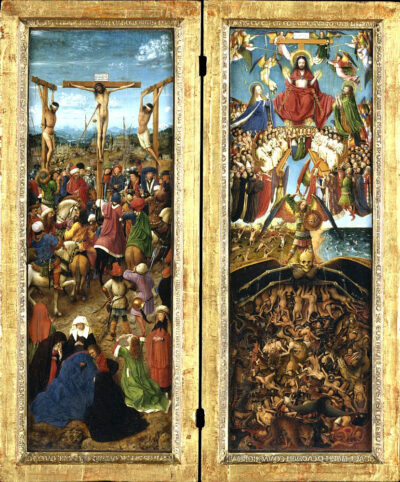
Christ as Martyr and Master
Crucifixion and Last Judgement diptych, c. 1430–1440 by Jan van Eyck (1390–1441)
To refer back to the human predicament of slavery (in its different forms) I am using the same metaphor from my previous articles [see Origins of Violence and Resistance Culture] based on Jan van Eyck’s (c. 1390 – 1441) painting, Crucifixion and Last Judgement diptych (c. 1430–1440) where we see Christ as ‘Martyr’ and ‘Master’:
“In Christianity the rulers had a religion that assured their objectives. The warring adventurism of the new rulers needed soldiers for their campaigns and slaves to produce their food and mine their metals for their armaments and wealth. Thus, Christ was portrayed as Martyr and Master. In his own crucifixion as Martyr he provided a brave example to the soldiers, and as Master he would reward or punish the slaves according to how well they had behaved.”
The ‘warriors’ and the ‘domestics’ are watched over by the ‘lord’ (the all-seeing eye). This basic scenario is common to much of cinema narratives from early cinema to today’s blockbusters. The ‘warrior’ is the active protagonist upon which the narrative is focused, while the ‘domestics’ in general facilitate or impede the progress of the ‘warrior’ protagonist. The important point in this scenario is that the protagonist is ultimately working for the ‘man’, e.g., criminal gangs, mafia dons, the bourgeois government, the deep state, secret services etc. – to defend the state, not to overthrow it.
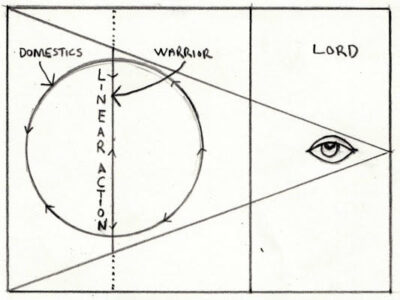 (1) Linear action (Illustration by Caoimhghin Ó Croidheáin)
(1) Linear action (Illustration by Caoimhghin Ó Croidheáin)
His/her role has become more complex over time, and he/she is used to maintain or expand the dominant position of the ‘lord’, or the all-seeing eye that surveys and controls the action. The ultimate holders of power are not necessarily present or seen but operate in the background controlling the action. The action contained within the film contains the range of sight of the ‘all-seeing eye’ but is presumed to ‘see’ before and after the film narrative. The action of the ‘warrior’ is linear because it does not change or threaten the position of the ‘lord’.
Early cinema
An early example of such a structure is the Bataille de boules de neige (Snow Fight) recorded by the Lumiére brothers in 1896. It is believed that the people throwing the snowballs at each other were from the local factory. A cyclist comes upon the scene, cycles into the centre of the group and is knocked off his bicycle by the snowball throwers and his hat falls on the ground. He gets up, grabs his bike, and cycles off without his hat. This short scene has all the elements of a movie: documentary (people throwing snowballs) combined with a narrative/story (cyclist cycles into scene and leaves), combined with drama/action (cyclist falls off his bicycle, loses his hat).
Thus, in this scenario the cyclist is the ‘warrior’ and the people throwing the snowballs from the local factory are the ‘domestics’. There is the interplay of the two worlds of the ‘warrior’ and the ‘domestics’ as the cyclist protagonist enters and leaves again in this short ‘story’ (he arrives / he falls off / he leaves). The ‘lord’ is not included in the film (except as the all-seeing eye of the camera itself).
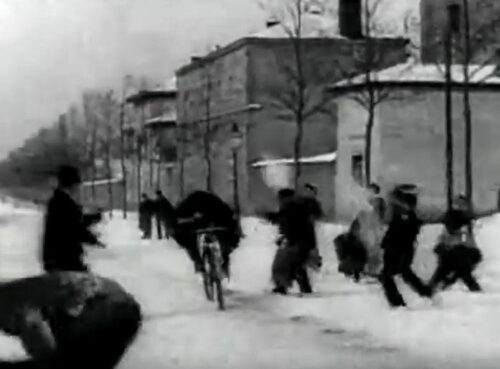 Bataille de boules de neige (Snow Fight) (1896) short silent film produced by the Lumiére brothers. (See video here)
Bataille de boules de neige (Snow Fight) (1896) short silent film produced by the Lumiére brothers. (See video here)
Italian Neo-Realism
The same type of action is played out in the later Italian Neo-Realist film, The Bicycle Thieves (1948). The protagonist meets with his wife telling her he needs to get a bicycle to secure his new job offer. He marches on ahead of her, only stopping when his wife (who is carrying two buckets of water) needs help to walk down a small incline, and then marches off forcefully again. As the ‘warrior’, he engages with the ‘domestic’ only when his help/action is needed but he is mainly concerned with his problem of securing a bike so he can secure a wage and an income for his family. The drudgery of her ‘domestic’ role is in sharp contrast to the ‘action’ of his linear ‘warrior’ role.
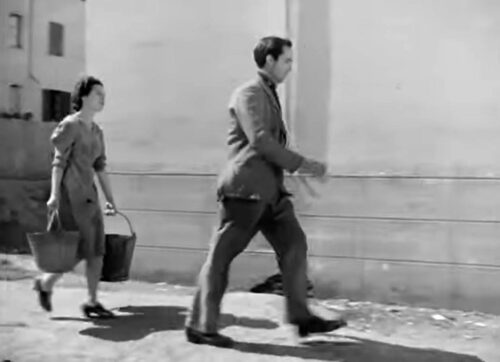 Bicycle Thieves (Italian: Ladri di biciclette) (1948) Italian neorealist drama film directed by Vittorio De Sica.
Bicycle Thieves (Italian: Ladri di biciclette) (1948) Italian neorealist drama film directed by Vittorio De Sica.
If a ‘domestic’ ever becomes active, he/she switches over to become a ‘warrior’ protagonist. Over time the ‘warriors’ expanded to include different ethnicities and sexualities. The ‘warriors’ are often alienated from the ‘domestics’ as they are often shown in cinema as a loner, undomesticated, and/or a whisky drinking hero.
Fundamentally, the ‘warrior’ is active for himself or for the needs of the elites but is never threatening to the system itself. This basic format can be seen repeatedly in films from early cowboy movies, James Bond, Mission Impossible (Ethan Hunt), Jack Reacher, The Matrix (Neo), John Wick, etc.
Dialectical Action: ‘sticking it to the Man’
However, there are films where the ‘warrior’ narrative changes from a linear type of thinking to a dialectical consciousness whereby he/she slowly becomes aware of his/her entrapment, oppression, or enslavement. This awareness gradually develops until eventually the protagonist confronts the ‘lord’ and throws off his/her oppression. The power of the ‘all-seeing eye’ breaks down and the protagonist escapes or changes the world, while at the same time breaking the hold of the vanquished overlord.
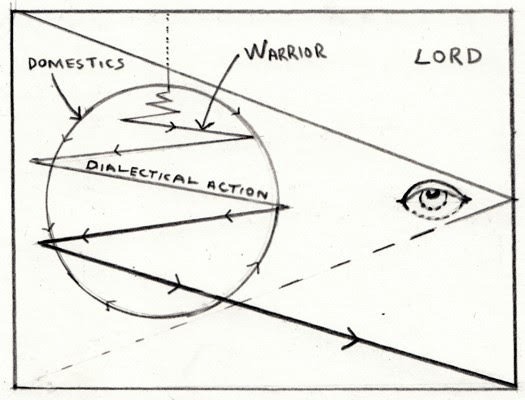 (2) Dialectical Action (Illustration by Caoimhghin Ó Croidheáin)
(2) Dialectical Action (Illustration by Caoimhghin Ó Croidheáin)
The film The Truman Show (1998) depicts such a journey on a personal and philosophical level. As Truman Burbank becomes gradually aware of the limitations of his artificial world, the prospect of freedom is too powerful, and he decides to go through his dome door and leave the monitored world forever. He is given the opportunity to talk directly to the ‘all-seeing eye’, his ‘lord’, Christof (the show’s creator and executive producer) but ultimately, he rejects Christof’s pleas to return to the ‘familiar’ world of total control. While this is not a political film, the dialectics of growing consciousness are well illustrated, in that returning to his previous unconscious state is an impossibility.
Over the years popular cinema has produced films of varying degrees of opposition to the boss, the lord, or the ‘the System’, for example, Salt of the Earth (1954), Spartacus (1960), The Battle of Algiers (1966), Che (2008),The White Tiger (2021), etc.

Poster for the film Spartacus (1960) directed by Stanley Kubrick.
First, Second and Third Cinema
The idea of using cinema to promote social change has been around for a long time. The social realism in the films of Frank Capra, or the cinema of the Italian Neo-Realists tend to represent the reality of poverty, but not necessarily the kind of social consciousness needed to question the hierarchy. In other words, they reflect the system but do not change it.
The Argentine filmmakers Fernando Solanas and Octavio Getino (members of the Grupo Cine Liberación) reflected on these types of problems when they wrote their manifesto ‘Hacia un tercer cine’ (‘Toward a Third Cinema’) in the late 1960s:
“Solanas and Getino’s manifesto considers ‘First Cinema’ to be the Hollywood production model that idealizes bourgeois values to a passive audience through escapist spectacle and individual characters. ‘Second Cinema’ is the European art film, which rejects Hollywood conventions but is centred on the individual expression of the auteur director. Third Cinema is meant to be non-commercialized, challenging Hollywood’s model. Third Cinema rejects the view of cinema as a vehicle for personal expression, seeing the director instead as part of a collective; it appeals to the masses by presenting the truth and inspiring revolutionary activism.”
The aim of Third Cinema was to go straight for the jugular, and to try and unite ‘Third World’ peoples experiencing oppression by depicting subjects in such a way as to inspire critical thinking and a revolutionary attitude. Both form and content were affected by Third Cinema principles, by emphasising the drama of everyday life over dramatic narratives, and by using amateur styles and not relying on expensive action set pieces. Examples are: Vidas Secas (Brazil, 1963), La Hora de Los Hornos (Argentina, 1968), Memorias del Subdesarrollo (Cuba, 1968), Antonio das Mortes (Brazil, 1969), Blood of the Condor (Bolivia, 1969), Mandabi (Senegal, 1969), México, la revolución congelada (Argentina, 1971), etc.
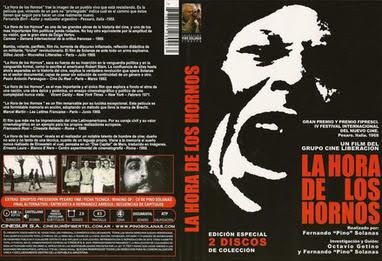
Cover of La Hora de Los Hornos (Argentina, 1968) directed by Octavio Getino and Fernando Solanas.
However, if the aim is to depict a growing socio-political consciousness, resulting in radical or revolutionary change or even an attempt at such change, then the films of First and Second Cinema can be just as effective as the films of Third cinema. The heroic, dramatic style of Hollywood in Spartacus (1960) made for a popular, successful film. The difficulty lies with the conservative, elite control of an expensive medium, coupled with elite control of conservative content.
Second Cinema is often described as European art cinema, which in the case of socio-political content is perceived to blunt any political message. Yet, the ‘art’ effects used in The Battle of Algiers (1966) were perceived to add to its sense of historical authenticity:
“[The writer and director] Pontecorvo and cinematographer Marcello Gatti filmed [The Battle of Algiers] in black and white and experimented with various techniques to give the film the look of newsreel and documentary film. The effect was so convincing that American releases carried a notice that “not one foot” of newsreel was used.”
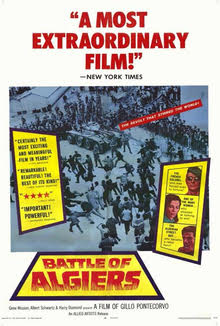
The Battle of Algiers (1966) Italian-Algerian war film co-written and directed by Gillo Pontecorvo. (U.S. theatrical release poster.)
That authenticity added to its negative reception and temporary banning in France, yet acclaim among academics and continued popularity to this day.
The negative side of Second Cinema comes down to what Solanas and Getino described as its inability to go beyond being merely the ‘progressive’ wing of Establishment cinema. They write:
“The most daring attempts of those film-makers who strove to conquer the fortress of official cinema ended, as Jean-Luc Godard eloquently put it, with the filmmakers themselves ‘trapped inside the fortress.’”
Thus, the strictures of Second Cinema were believed to have led to the concept of a militant new Third cinema that would develop new styles, forms and means of production and distribution that would break down the fortress walls.
There is no doubt that the expense and control of distribution in the past led to the frustration of radical filmmakers and their desire to overcome these difficulties with various alternative models of filmmaking and distribution. However, times have changed and the rise of cheaper digital cameras, editing software, and the internet itself as a means of distribution have changed the accessibility of filmmaking and film viewing. Films can be made now using phones and viewed using phones. Life experience in the ‘system’ can be turned into art by almost anyone now. The question is: will such contemporary cinema simply supply more reflections of the status quo, or will it rise above the media cacophony and become a new cinematic force for radical change?

Caoimhghin Ó Croidheáin is an Irish artist, lecturer and writer. His artwork consists of paintings based on contemporary geopolitical themes as well as Irish history and cityscapes of Dublin. His blog of critical writing based on cinema, art and politics along with research on a database of Realist and Social Realist art from around the world can be viewed country by country here. Caoimhghin has just published his new book – Against Romanticism: From Enlightenment to Enfrightenment and the Culture of Slavery, which looks at philosophy, politics and the history of 10 different art forms arguing that Romanticism is dominating modern culture to the detriment of Enlightenment ideals. It is available on Amazon (amazon.co.uk) and the info page is here.
Published by The 21st Century
The views expressed in this article are solely those of the author and do not necessarily reflect the opinions of 21cir.com
